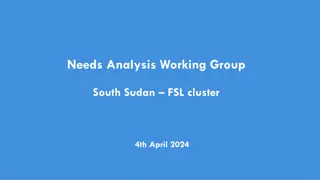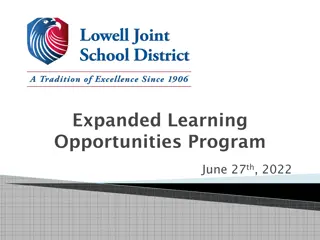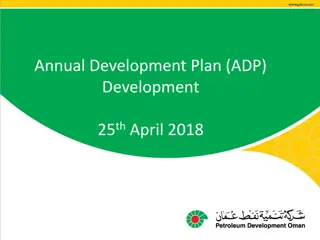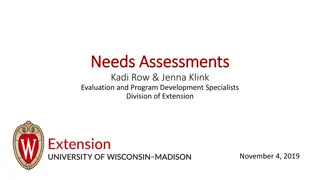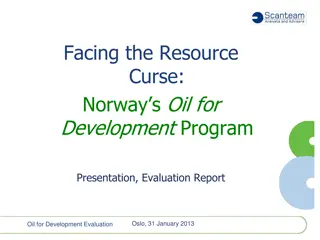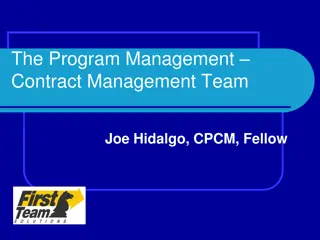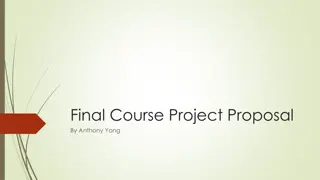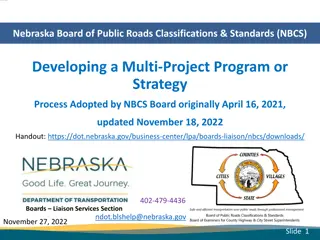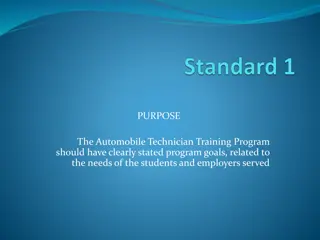Effective Program Development and Needs Analysis
Proper needs analysis is crucial for developing successful educational programs. Rushing into new program launches based on superficial reasons can lead to negative consequences. It's essential to carefully evaluate the demand, resources, and feasibility before proceeding with program development.
Download Presentation

Please find below an Image/Link to download the presentation.
The content on the website is provided AS IS for your information and personal use only. It may not be sold, licensed, or shared on other websites without obtaining consent from the author. Download presentation by click this link. If you encounter any issues during the download, it is possible that the publisher has removed the file from their server.
E N D
Presentation Transcript
Developing an Effective Program Needs Analysis MICHAEL WHITE DIRECTOR OF LEGAL AND REGULATORY AFFAIRS, ABHES MICHAEL SCHAFER VICE PRESIDENT OF ACADEMIC AFFAIRS, CAREER EDUCATION CORPORATION
How Many Times Have You Thought? LET S START A Nursing Surg Tech Radiography Respiratory Massage Dental Hygiene Anesthesia Tech Sonography PROGRAM!!!!!
Maybe the Thought Started With . . . It s a HOT field (We will fill classes easily!) I saw a great ad from one of my competitors The BLS said that it has been a big growth area My receptionist s doctor said she needs more (fill in the blank for the name of the program) It will look really good on our billboards It would support really great (high) tuition We have just enough room in the school to add this program
Those Teasers should be a STARTING PLACE NOT SO FAST! Have you really thought this through?
Teasers should be a STARTING PLACE It s a HOT field (They ll enroll by the droves!) I saw a great ad from one of my competitors The BLS said that it has been a big growth area My receptionist s doctor said she needs more (fill in the blank for the name of the program) It will look really good on our billboards It would support really great (high) tuition We have just enough room in the school to add this program
What Can Happen if You Jump on these Teasers? It s a HOT field (They ll enroll by the droves!) I saw a great ad from one of my competitors The BLS said that it has been a big growth area My receptionist s doctor said she needs more (fill in the blank for the name of the program) It will look really good on our billboards It would support really great (high) tuition We have just enough room in the school to add this program
Those Teasers should be a STARTING PLACE NOT SO FAST! Have you really thought this through?
Why Do A Needs Analysis? To meet ABHES requirements 1. 2. To add successful programs to the institution s portfolio
Why Do A Needs Analysis? To meet ABHES s requirements New Program Application Respond to the following questions in narrative format: 1. Why is this program being implemented? Include in this response the specific employment demand in the local geographic area and the means by which this demand was determined. Exhibit B, Summary of Market Survey, must be completed as part of this response.
Why Do A Needs Analysis? To meet ABHES s requirements New Program Application Respond to the following questions in narrative format: 2. Is the same or similar program offered by other institutions in your local area (i.e., 25- mile radius)? Yes No If yes, how was the need further justified?
Why Do A Needs Analysis? To meet ABHES s requirements New Program Application Respond to the following questions in narrative format: 3. What is the prospective student demand relative to first-year enrollment?
Why Do A Needs Analysis? To meet ABHES s requirements New Program Application Respond to the following questions in narrative format: 4. If applicable, identify the externship requirements for in this program, as follows: a. identify 1. length requirements (clock and/or credit hours) 2. person responsible for supervision and evaluation of students 3. person responsible for supervision and evaluation of externship sites b. identify the site arrangements made by a. location b. number of students at each location
Why Do A Needs Analysis? To meet ABHES s requirements New Program Application Respond to the following questions in narrative format: 9.(b) What will completion of the degree program do for the graduate that a lesser credential would not (e.g., job title and responsibilities, salary, transferability of credit) and how was this determined?
Why Do A Needs Analysis? To meet ABHES s requirements New Program Application Respond to the following questions in narrative format: 10. Is a credential required for graduates to work in the field? Yes No If yes,identify the credential and requirements for attainment, how prospective students are made aware of the requirements, and how the institution has determined that the curriculum will teach the students the necessary competencies required of the examination.
Why Do A Needs Analysis? To meet ABHES s requirements New Program Application Respond to the following questions in narrative format: 11. Has the institution determined that while not required, a credential is preferred for graduates to work in the field? Yes No If yes, What is that credential(s)? How was the desire for this credential determined?
Why Do A Needs Analysis? To meet ABHES s requirements New Program Application Respond to the following questions in narrative format: 14. (a) What is the total cost of tuition for the program? (b) What is the approximate average salary a graduate of this program can expect?
EXHIBIT B . . .The following are minimum requirements to be addressed relative to market demands: Survey of potential employers: Provide summary of survey results including time period and number of surveys. Externship availability: Provide signed contracts with externship sites. Advisory board: Provide list of representatives including name, organization, address, and telephone number. Salaries: General surveys on projected salaries graduates might expect that includes potential employers. Competition: Listing of other educational/training facilities, their programs and student population that are located within a 10-mile radius of the campus. Summary: The summarized information evidences a compelling need for the new program.Demonstration of the ability for the community to support this program. A documented plan based on the results of the Market Survey that determines the program s future enrollment, the effectiveness of the curriculum, and necessary future changes to address the needs of the local health care community.
HOW TO do A Needs Analysis So . . . The New Program Application tells you what you must do. But . . . HOW?
Essential Elements of the Needs Analysis Review the competition Review the geographic/data-based need for the program Understand the regulatory and accreditation requirements of the profession Conduct Advisory Board discussion Survey potential employers Review salary surveys and other relevant outcome information Review the availability of clinical sites Make a decision on projected program size
Review the competition Determine who else is in your market offering the same program (Accreditors, State agencies, IPEDS). Even if the data shows a future need, will the current area programs continue to grow at a rate that will satisfy future demand? Do not forget to review what offerings are being presented by the community college. More and more, community colleges are direct competitors for our potential students Will the area support your institutional goals for new programs and entry into new markets?
Research the geographic & data-based need for the program BLS Data: While valuable on a large scale, BLS data is generally stale information given the large gap between survey dates. Additionally, BLS data is not updated to reflect changes in market conditions. For example, the current recession has had a serious impact on job outlook, while at the same time increasing enrollment at postsecondary institutions that provide direct training Global Insights: Global Insights does provide critical information, updated annually and generally a better predictor, however the cost is prohibitive in many cases. IPEDS: IPEDS is a good resource to determine competition and completions, but should be utilized as a tool and not a definitive representation.
Understand the regulatory and accreditation requirements of the profession Don t make the mistake of not investigating programmatic accreditation While most allied health professions remain unregulated, in many fields hiring preference (and acceptance by clinical affiliates) is directly influenced by programmatic accreditation and the ability for graduates to sit for a certification or registry examination Determine how long it takes to go through the programmatic accreditation process Determine how programmatic accreditation will affect your future staffing decisions
Conduct Advisory Board discussion The typical Advisory Board for allied health programs includes, among others, representatives from the local health care community. In the decision-making process, it is strongly advised that an ad hoc program advisory board is formed early in the process relying heavily on this group The members of the Board can provide current information on the upcoming employment and clinical availability The Advisory Board membership should include active professionals who have a good knowledge of current salaries and employment characteristics
Survey potential employers Physically survey local potential employers on their future hiring needs and trends. This cannot be underestimated and the larger the number of responses, the better for making decisions. Often you may want to outsource these surveys to remove any potential bias from employers and to keep your plans proprietary from your possible future competition Find out what are the desirable training characteristics are for future employment and extern candidates. These would include length and depth of training, necessity of programmatic accreditation, and overall educational background of the students
Review salary surveys and other relevant outcome information This information is a necessary component and cannot rely only upon BLS statistics Much of the information is anecdotal and should be viewed as such. Employers will often state salaries that are smaller than the real salary and practitioners sometimes inflate the salaries to drive their own economic interests. In some fields, salary survey information from professional organizations (i.e. SDMS, AST, ARRT) Valid salary information should give you the basis for setting program price. As evidenced by the current national discussion, there is an expectation that program cost is roughly aligned with potential earnings (see the recent DOE Neg Reg discussions on gainful employment )
Review the availability of clinical sites Much of this can be completed during the review of potential employers, but in best practice, it is a separate exercise. For entry-level programs (medical assistant, pharmacy tech, etc) where there is a fairly constant employment stream, this can be a simple exercise In the arena of specialty programs (radiography, nursing, Sonography, etc) this is one of the most critical decision points in moving forward with a new program or campus location. Most of these programs require a significant clinical component, often up to 40-49%, and a lack of confirmed sites will cause huge future issues. It is a very dangerous and risky proposition to move forward with this type of program under the assumption that you will have the clinical sites when you actually need them (the Field of Dreams approach) A reality of today s clinical marketplace is the use of educational contributions. Over the last several years, clinical affiliates have become much more aggressive in their requirement that programs must make some sort of payment or contribution in order to allow your students to complete their externships at their site.
Make a decision on projected program size The previous topics should drive initial program size projections. If the goal is to have a sustainable program, a school is far better off opening slow and growing as the community demand (employment outcomes) and clinical availability is assessed through experience. If there is a programmatic accreditor involved, note that many of them require a program to set enrollment caps. The expectation is that you can demonstrate community demand and clinical demand and justify the enrollment number. However, once this number is set, you will likely need to demonstrate that market conditions have changed and that there is justification for increasing overall program enrollment
Last Step When do I do it all again?



